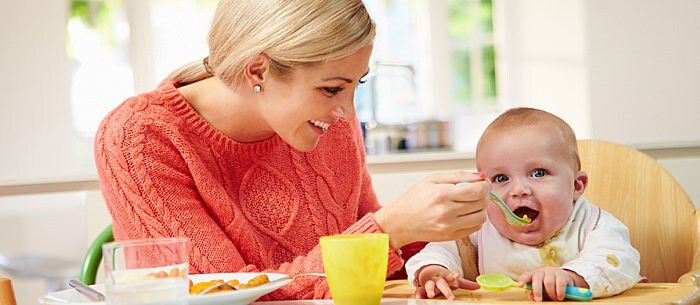
To see all three stages, check out The 3 Stages of Baby Food.
- Know When to Start
You’ll know that your baby is ready to graduate to chunkier foods when little or no food comes out of her mouth while she’s eating. Public health educator and child health nutritionist Leslie Hoglund says that each baby is different, but that is one of the first clear signs that your baby is ready. “The tongue thrust that facilitates breastfeeding or bottle-feeding changes to pulling food into the mouth, with swallowing happening effectively,” she says. “Being able to sit well in a high chair is also a sign that a baby may be ready for thicker foods.” Most babies show signs of readiness for thicker foods at 6 to 8 months of age.
- Choose the Right Stage 2 Foods
Until now, you’ve probably fed your baby cereal, veggies and fruit purees. Sylvia Klinger, a dietitian, family nutritionist and founder of Hispanic Food Communications, says that stage 2 is the time to try new textures and flavors. And once you’ve established that each individual food doesn’t give your baby an allergic reaction, you can start creating exciting combinations. “At about 6 months old, you can combine foods such as meat and vegetables together,” she says. Meats and other foods should be strained like the ones you find in store-bought baby foods — thicker than purees, but not large chunks of food.
For breakfast, Klinger says a 6-month-old baby can try half a cup of cereal and some banana mashed up with a fork. Then at 7 or 8 months, add things like unsweetened yogurt, cottage cheese and pureed tofu. Adding a little formula or breast milk to mashed or pureed tofu can help it thin it if need be.
And don’t forget the veggies! Choose a variety of yellow, orange and green veggies for your little one. Blended veggie mixtures may contain carrots, sweet potatoes, peas, spinach, squash and zucchini. Unsalted and soft-cooked veggies can be diced for your baby, or you can add a little water to mix a thick liquid. You can also strain fruits such as peaches, pears, apples, apricots and prunes.
The American Academy of Pediatrics (AAP) says that 6- to 8-month-old babies generally eat about four ounces of food at each meal — that’s the size of a typical jar of strained baby food.
- Stay Away From These Foods
The AAP notes that stage 2 baby food should not include anything that requires chewing because it poses a choking hazard. This includes hot dogs, nuts, seeds, chunks of meat, cheese, hard fruit, grapes, popcorn and raw veggies.You should also hold off on foods that could cause an allergic reaction — nuts, peanut butter, eggs and fish — until your baby’s first birthday. Continue to introduce new foods one at a time, and keep a chart of any reactions your baby has. If your little one shows signs of food allergies such as vomiting, diarrhea or rashes, discontinue the food and let her pediatrician know.
- Let Your Baby Help
Eating by herself is a big step, and stage 2 is when it can start happening. Hoglund says that although most babies master using a spoon between 18 to 24 months old, you should let your baby hold a spoon to help feed herself, as it will help her develop. “She’ll make a mess, but that’s OK — babies learn by doing,” Hoglund says. “She’ll be excited if some of the pureed peas and carrots on the spoon make it into her mouth, and before long, she’ll be feeding herself like a pro.”Your little one can also feed herself chunks of soft foods. Put diced banana, cooked carrots or peaches on your baby’s tray for her to pick up. Hogland says, “Skills in grasping food give babies motivation to self-feed.” Plus, let’s face it, a new eater trying to master the pincer grasp is pretty darn cute.
Check out Stage 3 Baby Food, for when your baby is ready for thicker solids.
Sandy Wallace is a busy mom and freelance writer who enjoys sharing family and parenting advice.
* This article is for general informational purposes only. It is not intended nor implied to be providing medical advice and is not a substitute for such advice. The reader should always consult a health care provider concerning any medical condition or treatment plan. Neither Care.com nor the author assumes any responsibility or liability with respect to use of any information contained herein.
